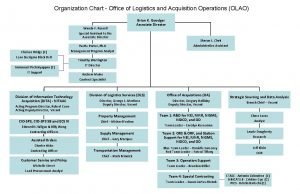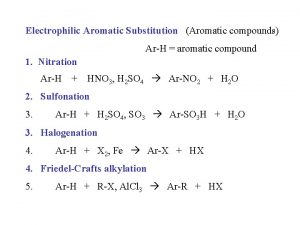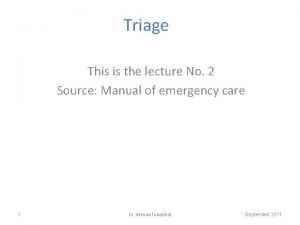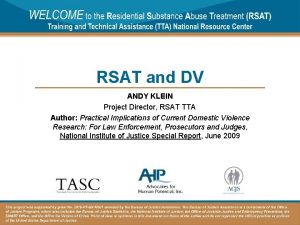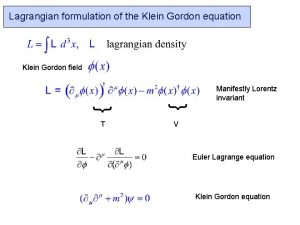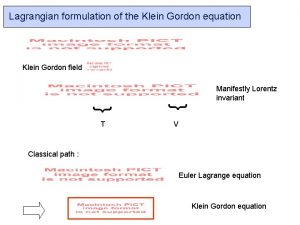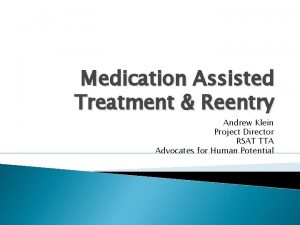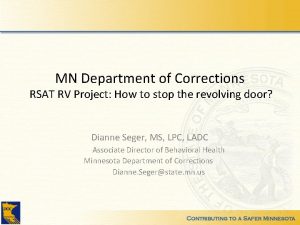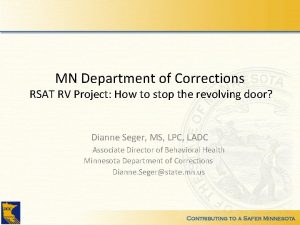RSAT and DV ANDY KLEIN Project Director RSAT






































- Slides: 38

RSAT and DV ANDY KLEIN Project Director, RSAT TTA Author: Practical Implications of Current Domestic Violence Research: For Law Enforcement, Prosecutors and Judges, National Institute of Justice Special Report, June 2009 1

WHY SHOULD RSATS WORRY ABOUT DV? RSAT inmates are disproportionately likely to be DV perps or victims. 2

Why should RSATs worry about DV? Approximately 35– 60% of male and female patients in substance abuse treatment committed at least one act of physical IPV in the past year. Brown TG, Werk A, Caplan T, Shields N, Seraganian P (1998) The incidence and characteristics of violent men in substance abuse treatment. Addict Behav 23: 573– 586. doi: 10. 1016/S 0306 -4603(98)00004 -5. Chermack ST, Fuller BE, Blow FC (2000) Predictors of expressed partner and non-partner violence among patients in substance abuse treatment. Drug Alcohol Depen 58: 43– 54. doi: 10. 1016/S 0376 -8716(99)00067 -8. Chermack ST, Walton MA, Fuller BE, Blow FC (2001) Correlates of expressed and received violence across relationship types among men and women substance abusers. Psychol Addict Behav 15: 140– 151. doi: 10. 1037//0893 -164 X. 15. 2. 140. Chermack ST, Blow FC (2002) Violence among individuals in substance abuse treatment: The role of alcohol and cocaine consumption. Drug Alcohol Depen 66: 29– 37. doi: 10. 1016/S 0376 -8716(01)00180 -6. Murphy CM, O’Farrell TJ (1994) Factors associated with marital aggression in male alcoholics. J Fam Psychol 8: 321– 335. doi: 10. 1037/08933200. 8. 3. 321. Stuart GL, Moore TM, Ramsey SE, Kahler CW (2003) Substance abuse and relationship violence among men court-referred to batterer intervention programs. Subst Abuse 24: 107– 122. doi: 10. 1080/08897070309511539. Maiden RP (1997) Alcohol dependence and domestic violence: Incidence and treatment implications. Alcohol Treat Quart 15 (2): 31– 50. doi: 10. 1300/J 020 v 15 n 02_03. Stuart GL, Moore TM, Ramsey SE, Kahler CW (2003) Relationship aggression and substance use among women court referred to domestic violence intervention programs. Addict Behav 28: 1603– 1610. doi: 10. 1016/j. addbeh. 2003. 08. 038. 3

Why should RSATs worry about DV? Substance abuse is associated with DV victimization as well. Chermack ST, Walton MA, Fuller BE, Blow FC (2001) Correlates of expressed and received violence across relationship types among men and women substance abusers. Psychol Addict Behav 15: 140– 151. doi: 10. 1037//0893 -164 X. 15. 2. 140. Hien D, Ruglass L (2009) Interpersonal partner violence and women in the United States: An overview of prevalence rates, psychiatric correlates and consequences and barriers to help seeking. Int J Law Psychiat 32: 48– 55. doi: 10. 1016/j. ijlp. 2008. 11. 003. Chermack ST, Murray RL, Walton MA, Booth BA, Wryobeck J, et al. (2008) Partner aggression among men and women in substance use disorder treatment: Correlates of psychological and physical aggression and injury. Drug Alcohol Depend 98: 35– 44. doi: 10. 1016/j. drugalcdep. 2008. 04. 010. El-Bassel N, Gilbert L, Schilling R, Wada T (2000) Drug abuse and partner violence among women in methadone treatment. J Fam Violence 15 (3): 209– 228. doi: 10. 1007/s 10896 -008 -9183 -6. El-Bassel N, Gilbert L, Frye V, Wu E, Go H, et al. (2004) Physical and sexual intimate partner violence among women in methadone maintenance treatment. Psychol Addict Behav 18 (2): 180– 183. doi: 10. 1037/0893 -164 X. 18. 2. 180. Gilbert L, El-Bassel N, Chang M, Wu E, Roy L (2012) Substance use and partner violence among urban women seeking emergency care. Psychol Addict Behav 26 (2): 226– 235. doi: 10. 1037/a 0025869. Kantor GK, Straus MA (1989) Substance abuse as a precipitant of wife abuse victimization. Am J Drug Alcohol Abuse 15: 173– 189. doi: 10. 3109/00952998909092719. Stith SM, Smith DB, Penn CE, Ward DB, Tritt D (2004) Intimate partner physical abuse perpetration and victimization risk factors: A metaanalytic review. Aggress Violent Behav 10: 65– 98. doi: 10. 1016/j. avb. 2003. 09. 001. 4

Why DV? i. e. Barnstable County RSAT Program (188 males) • Prior Arrests: 246 Protective Order Violations! • 33% had prior DV convictions • Many had active protective orders 5

Why DV? Post Release Recidivism: • 16 arrested for new substance abuse offenses • 13 arrested for Violation of Protective Order • 17 arrested for assaults 6

Why DV? • The overwhelming majority of women in prison are survivors of domestic violence. Three-quarters have histories of severe physical abuse by an intimate partner during adulthood, and 82% suffered serious physical or sexual abuse as children (ACA) • In 2007 more than 50% of the women in jail reported to have been physically or sexually abused before their imprisonment, as were ~10% of the men (BJS) 7

Why DV? Typical pathways for women to end up incarcerated: • DV →→trauma (PTSD) →→self medication/binge drinking →→crime →→incarceration • Abusers →→DV Victims to Commit Crimes →→incarceration 8

What is DV? Intimate Partner Violence Spouse, boy/girl friend, current or former, with or without children, date Intra-Family Violence Other family member, blood relative, in-law, intergenerational, siblings, child abuse 9

What is DV? • Physical, sexual, psychological, economic abuse and stalking are the five multifaceted methods of violence and abuse that perpetrators utilize to achieve, maintain and regain control of their intimate partners. Coercion or terroristic threats coupled with any of the five methods of abuse is intimate partner violence. [CDC & Klein, 2009] 10

What is DV? NOT: • Situational Violence: Isolated stemming from conflict turned violent • Violent Resistance • Trauma-related hyper aggressiveness If no history of coercion, intimidation, or threats 11

Which Jail & Prison Inmates Most High Risk For Reabuse? ? 12

Why RSAT inmates? Risk Factors for Reabuse: • Prior criminal history • Younger • First offense at early age • Substance/alcohol abuse 13

Why RSAT inmates? 14

Which RSAT inmates at risk for most injurious abuse? From their hospital beds, victims report: • • 63. 7% alcohol abusers 36. 7% drug abusers 51. 6% drinking at time of assault 14. 8% on drugs at time of assault Studies add: • Intermittent employment/ recent unemployment • Less than high school education 15

Which RSAT inmates at risk for most injurious abuse? • • Access to firearms Threats to kill Prior strangulations Forced sex Escalating assaults Control over daily activities Children not abusers Short courtships 16

Which female RSAT inmates at risk for lethal abuse? • Suffered most severe, chronic and increasing abuse • Fewer resources, including employment, high school education. • In long term relationship 17

Which RSAT inmates most vulnerable for DV victimization? • • • Unmarried First child young age Poorly educated Low education Child sexual victimization Relationship in which substance abuse and crime are featured • Depressed 18

What RSAT inmates most vulnerable for DV victimization? • Some research indicates that substance use/abuse and alcohol abuse by women can increase the risk of being victimized by one’s domestic partner as well as inhibit a victim’s capacity to protect herself, increasing frequency of abuse over time. 19

Which RSAT inmates most vulnerable for DV victimization? • There is consensus in the literature that binge drinking and abusive drinking among women is more problematic than for men. Women become intoxicated after drinking half as much, metabolize alcohol differently, and have greater risk of dying from alcohol-related accidents and higher risk of being victims of violence and suffering from depression. 20

What RSAT inmates most vulnerable for DV victimization? • A general population study across New Zealand found that binge drinking by men and women (5 or more drinks/ at least once a month) → → twice as likely to be an aggressor → → three times as likely to be a victim of partner aggression vs. people who did not binge. • Although binge drinking → → female & male aggression, men → → more likely physically violent towards partners 21

What is the impact RSAT inmates experienced as a result of DV? National Survey (2011): • Fear • Trauma/Depression • Injury • Pregnancy • Missed work/school • Sexually transmitted disease • Medical care • Homelessness 22

What is the impact RSAT inmates experienced as a result of DV? National Survey (2011): Only 19. 2% women victims reported no adverse effects while 65. 3% of men reported no adverse effects of DV. 23

What is the impact RSAT inmates experienced as a result of DV? For Perps: To the extent that their DV crimes are unarrested, unprosecuted and unsentenced, abusers will be undeterred from future DV crimes. RSAT Implications: Just because the RSAT abuser has been incarcerated, if for a non-DV crime, does not mean he will be deterred from more DV upon release. Research indicates, in fact, may be significantly more likely to reabuse. 24

So what’s a RSAT program to do? Isn’t substance abuse treatment enough? ! 25

So what’s a RSAT program to do? 1. Identify Abusers/Victims 2. Identify resources to integrate into or supplement RSAT programming for both (separately) 26

So what’s a RSAT program to do? Identifying abusers • Prior dv/assault arrests/ police incident reports • Prior participation in batterer intervention program • Child protective services case • Had/has civil/criminal protective order • Federally prohibited from possessing firearm (NICS) • Interview current or former intimate partner 27

So what’s a RSAT program to do? Identifying Victim Ask if former/current intimate partner: • ever hit/ slapped/ pushed/ choked her • threatened her/ children/ family pet • fear he might hurt you/ children • violently or constantly jealous or controls your daily activities • have you ever left him/her or separated after living together or being married • does he follow or spy on you, leave threatening messages • has anyone else worried about your safety? 28

So what’s a RSAT program to do? Resources for abuser treatment • State Domestic Violence (and Sexual Assault) Coalition for certified/ recommended batterer intervention program (BIP) contacts • State agency responsible for certifying BIPs • Child Protective Services for recommended parenting programs 29

So what’s a RSAT program to do? • Monitor communications with intimate partner to ensure allowed and not abusive (threatening, controlling, blaming) • Inform parole of abuser status/ potential vulnerable victim in the community • Check state protective order file – Make sure firearms are removed from household – Make sure parole aware of any current no contact/ stay away orders – Make sure victim warned of pending release 30

So what’s a RSAT program to do? For Victims Trauma informed and trauma specific treatment: supplementing or with substance abuse treatment (i. e. Seeking Safety, TAMAR) 31

So what’s a RSAT program to do? See: http: //www. rsat-tta. com/Files/Trainings/Trauma_Informed_Manual 32

So what’s a RSAT program to do? Victim Support and Safety Planning • State DV (and SA) Coalition Mentoring/support programs/ volunteers • National DV hotline: 1 -800 -799 -SAFE Direct connection to DV resources available in the caller’s area provided by a advocate 33

So what’s a RSAT program to do? In 1998, the Iowa Department of Corrections implemented Moving On for women under correctional supervision. Evaluation found it had statistically significant lower re-arrest rates than the matched comparison group up to 18 months. Gender-responsive programming, targeting specific risk factors and needs unique to women, is effective in reducing recidivism. Further, cognitive behavioral programming fits the bill as an appropriate treatment modality for women offenders. 34

So what’s a RSAT program to do? Moving On 26 -session, curriculum based programs combining Relationship Theory, Motivational Interviewing and Cognitive-Behavioral Intervention in 9 modules: 1) setting the context for change; 2) women in society; 3) taking care of yourself; 4) family messages; 5) relationships; 6) coping with emotions and harmful self-talk; 7) problem-solving; 8) becoming assertive; and 9) moving on. Designed to address the gendered risks and needs of women offenders, including dealing with histories of trauma and abuse, mental health issues, substance abuse, parenting issues, and relationship issues. The program helps participants realize why they offend and motivates them to use positive coping mechanisms to avoid these criminogenic circumstances and choose positive, crime-free alternatives. 35

So what’s a RSAT program to do? Jail Program for Incarcerated Female DV Victims Unlike other inmates, abused women behind bars may not be looking forward to their release due of abusive partners. Help and Emergency Response Inc. (DV shelter in Portsmouth, Virginia) sponsors a DV counseling program for women in Hampton Roads Regional Jail. Focuses on DV warning signs and how abuse can lead to low self-esteem. Jail officials are supportive, having noticed that during substance abuse classes, inmates also talked about DV in their lives. 36

Thanks for Listening 37

Next Presentation PREA Basics: What RSAT Sites need to Know July 17, 2013, 2: 00 PM EDT This webinar will familiarize participants with the history of the Prison Rape Elimination Act of 2003 (PREA). Since the passage of the federal law, implementation efforts have focused on developing standards at the national level and policies at the state and local levels. PREA law was universally supported by bipartisan effort; however, the controversy begins when facilities and jurisdictions need to define, develop procedures and policies to prevent, and address it. This webinar will outline progress we have made in implementation and standards over the last 10 years. The presenter, a former PREA administrator, will discuss the PREA basics and the impact they may have for RSAT programs. Presenter: Niki Miller 38
 D365 rsat
D365 rsat Rsat program in georgia
Rsat program in georgia Patr program utah
Patr program utah Ktkswan
Ktkswan English comic actor and film director
English comic actor and film director English comic actor and film director
English comic actor and film director English comic actor and film director
English comic actor and film director Dmf dentistry
Dmf dentistry Klein oak swim and dive
Klein oak swim and dive The text-based director, also known as the
The text-based director, also known as the Deberes de un director de escuela
Deberes de un director de escuela I scurt
I scurt Tanggungjawab pengarah syarikat
Tanggungjawab pengarah syarikat Director of operations org chart
Director of operations org chart Director comercial turistico tenerife
Director comercial turistico tenerife Oliver stone
Oliver stone Salaam bombay summary
Salaam bombay summary Directors brief
Directors brief Types of span of control in organization
Types of span of control in organization Ict team structure
Ict team structure Emerald director usana salary
Emerald director usana salary Wrap it up signal
Wrap it up signal Fashion show staff positions
Fashion show staff positions Importance of audience in theatre
Importance of audience in theatre Edg and ewg chart
Edg and ewg chart Vestuario de teatro griego
Vestuario de teatro griego Ficha tecnica de la pelicula el pianista
Ficha tecnica de la pelicula el pianista Regional de alajuela
Regional de alajuela Director of technical education hp
Director of technical education hp Managing director message for company profile
Managing director message for company profile Director of class
Director of class Change management image
Change management image Bartholomew cubbins jared leto
Bartholomew cubbins jared leto Pt demographics
Pt demographics Qualification of a director
Qualification of a director Cisco threat intelligence director
Cisco threat intelligence director Organigrama ani
Organigrama ani Orange county medical director
Orange county medical director Discussion director examples
Discussion director examples













